REPORTS AND PUBLICATIONS

Aquaculture in Eastern
Canada - A Growing Opportunity
The text version of the presentation is available
below. The PowerPoint presentation is
available as a Microsoft PowerPoint file (*.ppt) by following
this link.
Credit: This presentation was developed in
collaboration by the Provinces of Nova Scotia, New Brunswick, Newfoundland
and Labrador, Prince Edward Island and Quebec in November 2005. Fisheries
and Oceans Canada thanks these Provinces for the permission to use the
presentation for this website.
Slide 1 - Aquaculture in Eastern Canada - A Growing
Opportunity - November 2005

Slide 2
"Large scale commercial aquaculture is little more than 30 years old.
New technologies, new breeds and newly domesticated species of fish offer
great hope for the future. They promise a blue revolution in this century to
match the green revolution of the last."
The Economist: 9 – 15 August 2003
Blue Revolution – the promise of fish farming.
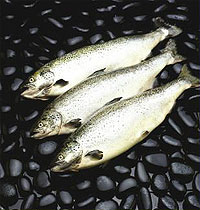 
Slide 3 - World Seafood Production (FAO)

Slide 4
Economic Profile
Aquaculture In Eastern Canada

Slide 5 - Total Production & Value
NB, NS, NL, PEI, PQ

Source: Stats Canada
Slide 6 - Major Species Farmed By Volume 2004

Source: Stats Canada
Slide 7 - Key Industry Drivers
Rural Based
Providing an Economic Alternative for Rural & Coastal Communities.
Residents can stay, & educated young people can return, to their
communities.
Science Based
Highly Efficient Producer of Protein using Science & Technology.
Market Based
We are in the Food
Industry - Growing Demand by Consumers. Producing High Quality,
Safe, Nutritious, Tasty products year round.
Slide 8 - Rural Based Industry
Major Impact in Rural Eastern Canada

Slide 9 - Rural Stability – Direct Employment 2003

- Aquaculture has brought much needed stability & employment to rural
eastern Canada helping to minimize out-migration. It is an alternative
for educated young people to pursue a career in their home communities.
Source: Atlantic Task Force Report & CAIA Employment Study
Slide 10 - Faces of the Industry

Researcher |
From Truck Drivers to Veterinarians the East Coast
Aquaculture Industry has a major impact across many sectors
of the economy. |

Veterinarian |

Biologist/ Manager
|
Slide 11 - Faces of the Industry

Processor |
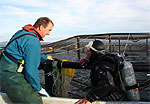
Diver |
| |
Jobs |
Payroll |
|
Direct |
2018 |
$56 Million |
|
Indirect |
2997 |
$46 Million |
|
TOTAL |
5018 |
$102 Million |

Biologists |
75% of industry employees are under 40 years of age.
|

Technicians
|
Slide 12 - On Farm Employment

Slide 13 - Support Industries
Aquaculture is supported by many other industries both near to
and far from the coast.

Feed Mills NB, NS |
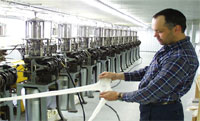
Shellfish Socks, Shippagan, NB |

Boat & Barge Making, All Provinces |

Cage & Net Making, All Provinces
|
Slide 14
Science Based Industry

Slide 15 - Aquaculture Education & Research Institutions

Slide 16 - Monitoring & Sustainability
The Industry and Government are working together to provide for
Sustainable Aquaculture Development. Programs include:
- Environmental Impact Assessments pre licensing.
- Environmental Monitoring & Codes of Practice.
- Canadian Shellfish Sanitation Program.
- National Aquatic Animal Health Program.
- Processing Plant Quality Management Program (QMP).
- Safe Quality Food Institute Certification Program.
 
Slide 17 - Fish Health Management
- All fish diseases originate in the wild.
- All fish are transferred ONLY after veterinary screening and
vaccinated against diseases.
- There is no evidence of disease being transferred from farmed to
wild salmon.
- Antibiotics are ONLY administered with a veterinarian’s certificate.
Farmed fish have the lowest antibiotic use of all farmed animals.
Slide 18 - Aquaculture & the Environment
-
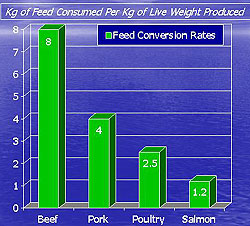 Fish
are the most efficient converter of feed to protein. Fish
are the most efficient converter of feed to protein.
- Salmon farming is one of the most efficient food production
industries.
- Salmon FCR’s of 2.4 kg’s in 1984 to 1.2 kg in 2004.
- Freshwater Consumption in Aquaculture is minimal to nil.
Source: Stats Canada Vista
Slide 19 - Market Based Industry
Producing Safe, Healthy Food in a Sustainable
Environment
 
Slide 20 - East Coast Proximity to Market
-
The
wealthiest consumer market in the world is on our doorstep.
-
No other aquaculture producing area can service it
faster or fresher.

Map Source: Google Slide 21 - Market Overview
- US aquaculture imports in the last 10 years have almost doubled from
$1.5 billion to $2.7 billion.
- Eastern Canada’s share of that market is $US 216 Million.
- Aquaculture’s success can be seen in the statistics for per capita
growth of various foods in the North American market between 1990 –
2004:
- Beef, Pork and Seafood overall = No growth.
- Chicken = 97% growth, success story.
- Salmon = 2,200% growth due to aquaculture providing fresh, high
quality, year round supply.
Slide 22 - N. American 2003
Seafood Consumption
SPECIES
|
LBS PER PERSON
|
| Shrimp* |
4.00 |
| Tuna |
3.40 |
| Salmon* |
2.22 |
| Alaskan Pollock |
1.70 |
| Catfish* |
1.14 |
| Cod |
0.64 |
| Crab |
0.61 |
| Tilapia* |
0.54 |
| Clams* |
0.53 |
* Majority of the supply is from Aquaculture
Slide 23 - Marketplace Growth Opportunities

- Heart Healthy Foods.
- Brain Healthy Foods.
- Digestive Healthy Foods - Wellbeing & Sickness.
- Low Fats to Right Fats – Omega 3 Foods.
The opportunity is to educate consumers and the Retail &
Foodservice markets about the health benefits of our products.
Source: Future Trends in Food: 2005 Business Insights Ltd Publication
Slide 24
The Future for Eastern Canada
An Exciting Socio-Economic Opportunity
Slide 25 - Canadian Production Opportunities
| |
PROD’N
(000’s MT)
2000
|
PROD’N
(000’s MT)
2015
|
VALUE
($Millions)
2000
|
VALUE
($Millions)
2015
|
Salmonids
|
85 |
350 |
$ 511 |
$ 2,100 |
Cod
|
- |
128 |
- |
$ 545 |
Other Finfish
|
0.5 |
5 |
$ 5 |
$ 30 |
Mussels
|
17 |
52 |
$ 23 |
$ 69 |
Oysters
|
9 |
36 |
$ 14 |
$ 57 |
Clams
|
1 |
4 |
$ 4 |
$ 16 |
Other Shellfish
|
0.1 |
2 |
- |
$ 4 |
TOTAL AQUA
|
113 |
577 |
$ 557 |
$ 2,821 |
+ Value Added
+ Supply & Service
TOTAL
|
|
|
|
$ 500
$3231
$6,642 |
Source: OCAD/ACOA
Slide 26
Provincial Overviews
 Slide
27 - Newfoundland & Labrador Slide
27 - Newfoundland & Labrador
 The
#1 Seafood Processing Plant is on the south coast producing fresh Farmed
salmon year round. Aquaculture on the south coast employs 300 people &
co-exists with the traditional fishery. The
#1 Seafood Processing Plant is on the south coast producing fresh Farmed
salmon year round. Aquaculture on the south coast employs 300 people &
co-exists with the traditional fishery.

 Slide
28 - Newfoundland Aquaculture Slide
28 - Newfoundland Aquaculture
The opportunity
-
 500
years of living from the sea 500
years of living from the sea
- Abundant area for development
- Excellent water quality
- Existing infrastructure
- Community acceptance

 Slide
29 - Newfoundland Aquaculture Slide
29 - Newfoundland Aquaculture
Capability and expertise
-
 Skilled
workforce Skilled
workforce
- Aquaculture
- Processing
- Support sector
- R&D Capability
- Marine Institute
- Ocean Sciences Centre

 Slide
30 - Newfoundland Aquaculture Slide
30 - Newfoundland Aquaculture
Supportive Government
-
 Aquaculture
is a priority for rural economic development. Aquaculture
is a priority for rural economic development.
- Sustainable development strategy
- Streamlined approval process
- Business friendly
- Aquaculture Loan Guarantee

 Slide
31 - Prince Edward Island Slide
31 - Prince Edward Island
PEI's $70 million aquaculture industry co-exists with the
traditional fishing, agriculture and tourism industries.

 Slide
32 - Prince Edward Island Slide
32 - Prince Edward Island
 A
strong backbone with mussels… A
strong backbone with mussels…
-
Year round employment
-
Rural jobs
-
$50 million economic value
-
Modern processing facilities
-
Support institutions
 
 Slide
33 - Prince Edward Island Slide
33 - Prince Edward Island
 A
sea of opportunities…
-
An expanding oyster industry
-
Potential for off-shore mussel production
-
Value-added shellfish products
 
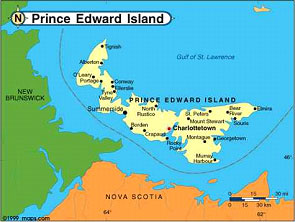
 Slide
34 - Prince Edward Island Slide
34 - Prince Edward Island
 Finfish
– room for development… Finfish
– room for development…
-
A huge resource of fresh and salt water
-
Certified facilities
-
Expertise in fish health services, diagnostics and training
-
Land-based production technology
 
 Slide
35 - Nova Scotia Slide
35 - Nova Scotia
A world leader in New Species Development supported by strong research
centres of excellence.

Abalone Farming |

Research |
 Slide
36 - Nova Scotians’ Opportunities in Aquaculture Slide
36 - Nova Scotians’ Opportunities in Aquaculture
-
 Atlantic
halibut, haddock, and cod R&D Atlantic
halibut, haddock, and cod R&D
- Diversified approach - clam, abalone, marine plants
- New technologies - off-shore facilities, marine & land-based farms
- Jobs for graduates in rural and coastal communities
- Close links with other Atlantic provinces on research and business
- 7400 kilometers of "Coastal Opportunities"
 Slide
37 - Nova Scotia’s Aquaculture Environment Slide
37 - Nova Scotia’s Aquaculture Environment
-
 Provincial
department staff monitor sites regularly Provincial
department staff monitor sites regularly
- Industry and Dept. promote sustainable use & environmental
stewardship
- All marine finfish and shellfish suspended aquaculture sites are
monitored
- NS aquaculture sites monitored meet or exceed Env. Can. standards
- World class vet. provide diagnostic and pathology lab services
 Slide
38 - Nova Scotia - Come to Prosper Slide
38 - Nova Scotia - Come to Prosper
-
 Nova
Scotia is well recognized as one of the best R&D places in N A Nova
Scotia is well recognized as one of the best R&D places in N A
- Significant strengths in biotechnology, nutrition, fish health and
aquaculture
- NS is a brand unto itself with strong NA seafood identification
- Safety of investment and quality of life in Nova Scotia - 2nd to
none
- Technical, business, R&D - Nova Scotia has the expertise
 Slide
39 - Québec : A Tradition of innovation Slide
39 - Québec : A Tradition of innovation
-
 More
than 150 years of history More
than 150 years of history
- Total sales of 12.4 M$ (2004)
- Many direct and indirect jobs
- Strong potential, particularly in Quebec’s maritime regions
Slide 40 - Québec : Freshwater aquaculture
-
 Freshwater
aquaculture responsible for 90% of all aquaculture sales Freshwater
aquaculture responsible for 90% of all aquaculture sales
- More than 2/3 of the sales go to lake and river stocking
- Main species are brook trout (60%) and rainbow trout (28%)
Slide 41 - Québec
Marine Aquaculture
-
 Started
in the mid-1980 Started
in the mid-1980
- Commercial production of mussels and scallops and less of urchins
and clams
- Sales of 1.2 M$ (2004)
- Priority for regional development
Slide 42 - Québec
Governmental action
- Commercial Aquaculture Act - 2004
- Freshwater Aquaculture Development Strategy in Quebec (STRADDAQ)
- Technical, scientific and financial support to enterprises
- Creation of a corporation for development of mariculture industry
(SODIM) and a corporation for research and development in continental
aquaculture (SORDAC)
 Slide
43 - New Brunswick Slide
43 - New Brunswick
A Significant Industry
- Second largest aquaculture producer in Canada
- Industry production value of $181 million in 2004
- Salmon Aquaculture is the largest crop in the Agri-Food Sector with
a value of $179 Million in 2004
 
 Slide
44 - New Brunswick Slide
44 - New Brunswick
Strong Support Sector
-
 Having
grown over the last 25 years, the New Brunswick aquaculture industry is
surrounded by a well developed support sector. Having
grown over the last 25 years, the New Brunswick aquaculture industry is
surrounded by a well developed support sector.
- feed mills,
- hatcheries,
- cage & net manufacturing,
- processing plants,
- private veterinary practices
- research institutions
- Vital to the continued development of aquaculture in Atlantic
Canada.
 Slide
45 - New Brunswick Slide
45 - New Brunswick
More than just salmon
-
 The
shellfish industry on the province’s east coast is also growing
significantly The
shellfish industry on the province’s east coast is also growing
significantly
- oyster industry forecasted worth $17 million by 2010
- popular cocktail oysters
- mussel farming expected to double production
- Alternate species opportunities
- Canada’s only sturgeon facility
- Halibut and cod at marine sites
- Broodstock programs for
-
Cod
(HMSC -cod genome project)
-
Arctic charr (CZRI)
 Slide
46 - New Brunswick Slide
46 - New Brunswick
Supportive Government
- Significant provincial investment in the industry.
- Loan guarantee program,
- Fish health unit,
- Extension services,
- Research & development support,
- Strategic planning support for industry,
 
Slide 47 - What Aquaculture Is
- Socially Sustainable.
- A rural industry for rural Canada
- Economically Sustainable.
- A financially sound investment in rural Canadian communities
- Environmentally Sustainable.
- An environmentally responsible industry producing high quality
seafood for the world marketplace.
| 














 Fish
are the most efficient converter of feed to protein.
Fish
are the most efficient converter of feed to protein.


![]() Slide
27 - Newfoundland & Labrador
Slide
27 - Newfoundland & Labrador The
#1 Seafood Processing Plant is on the south coast producing fresh Farmed
salmon year round. Aquaculture on the south coast employs 300 people &
co-exists with the traditional fishery.
The
#1 Seafood Processing Plant is on the south coast producing fresh Farmed
salmon year round. Aquaculture on the south coast employs 300 people &
co-exists with the traditional fishery.
![]() Slide
28 - Newfoundland Aquaculture
Slide
28 - Newfoundland Aquaculture  500
years of living from the sea
500
years of living from the sea
![]() Slide
29 - Newfoundland Aquaculture
Slide
29 - Newfoundland Aquaculture  Skilled
workforce
Skilled
workforce
![]() Slide
30 - Newfoundland Aquaculture
Slide
30 - Newfoundland Aquaculture Aquaculture
is a priority for rural economic development.
Aquaculture
is a priority for rural economic development.
![]() Slide
31 - Prince Edward Island
Slide
31 - Prince Edward Island
![]() Slide
32 - Prince Edward Island
Slide
32 - Prince Edward Island A
strong backbone with mussels…
A
strong backbone with mussels… 

![]() Slide
33 - Prince Edward Island
Slide
33 - Prince Edward Island



![]() Slide
34 - Prince Edward Island
Slide
34 - Prince Edward Island Finfish
– room for development…
Finfish
– room for development…




![]() Slide
36 - Nova Scotians’ Opportunities in Aquaculture
Slide
36 - Nova Scotians’ Opportunities in Aquaculture Atlantic
halibut, haddock, and cod R&D
Atlantic
halibut, haddock, and cod R&D![]() Slide
37 - Nova Scotia’s Aquaculture Environment
Slide
37 - Nova Scotia’s Aquaculture Environment Provincial
department staff monitor sites regularly
Provincial
department staff monitor sites regularly![]() Slide
38 - Nova Scotia - Come to Prosper
Slide
38 - Nova Scotia - Come to Prosper Nova
Scotia is well recognized as one of the best R&D places in N A
Nova
Scotia is well recognized as one of the best R&D places in N A![]() Slide
39 - Québec : A Tradition of innovation
Slide
39 - Québec : A Tradition of innovation More
than 150 years of history
More
than 150 years of history Freshwater
aquaculture responsible for 90% of all aquaculture sales
Freshwater
aquaculture responsible for 90% of all aquaculture sales Started
in the mid-1980
Started
in the mid-1980![]() Slide
43 - New Brunswick
Slide
43 - New Brunswick 

![]() Slide
44 - New Brunswick
Slide
44 - New Brunswick  Having
grown over the last 25 years, the New Brunswick aquaculture industry is
surrounded by a well developed support sector.
Having
grown over the last 25 years, the New Brunswick aquaculture industry is
surrounded by a well developed support sector.![]() Slide
45 - New Brunswick
Slide
45 - New Brunswick  The
shellfish industry on the province’s east coast is also growing
significantly
The
shellfish industry on the province’s east coast is also growing
significantly
![]() Slide
46 - New Brunswick
Slide
46 - New Brunswick
